|
Battle of Brandy Station
Brandy Station Civil War History
Battle of Brandy Station
Other Names: Fleetwood Hill
Location: Culpeper County
Campaign: Gettysburg Campaign (June-July 1863)
Date(s): June 9, 1863
Principal Commanders: Maj. Gen. Pleasonton [US]; Maj. Gen. J.E.B.
Stuart [CS]
| Battle of Brandy Station |
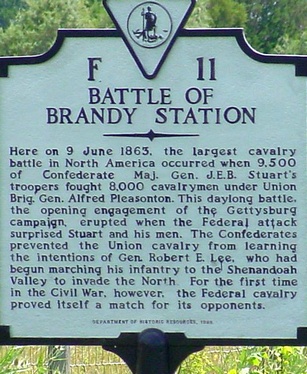
|
| Brandy Station and the Civil War |
Forces Engaged: Corps (22,000 total)
Estimated Casualties: 1400 total (US 900; CS 500)
Result(s): Inconclusive
Introduction: At dawn June 9, the Union cavalry corps under Maj. Gen. Alfred Pleasonton launched a surprise attack on Stuart’s cavalry
at Brandy Station. After an all-day fight in which fortunes changed repeatedly, the Federals retired without discovering Lee’s
infantry camped near Culpeper. This battle marked the apogee of the Confederate cavalry in the East. From this point in the
war, the Federal cavalry gained strength and confidence. Brandy Station was the largest cavalry battle of the war and the
opening engagement of the Gettysburg Campaign. The duel was also the largest cavalry engagement ever conducted on American
soil. See also Civil War Cavalry Organization.
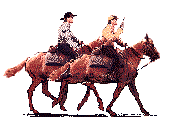
History: The
Battle of Brandy Station, also known as the Battle of Fleetwood Hill, was the largest predominantly cavalry engagement of
the American Civil War – as well as the largest to take place ever on American soil – and it was fought at the
beginning of the Gettysburg Campaign on June 9, 1863. Cavalry under the command of Union Maj. Gen. Alfred Pleasonton
launched a daring and thunderous assault against the formidable Confederate cavalry under Maj. Gen. J.E.B. Stuart. This map
reflects the distance between the small community of Brandy Station and a little known town known as Gettysburg.
Both communities, however, now hold respective positions in the annals of American history.
| Distance Between Brandy Station and Gettysburg |
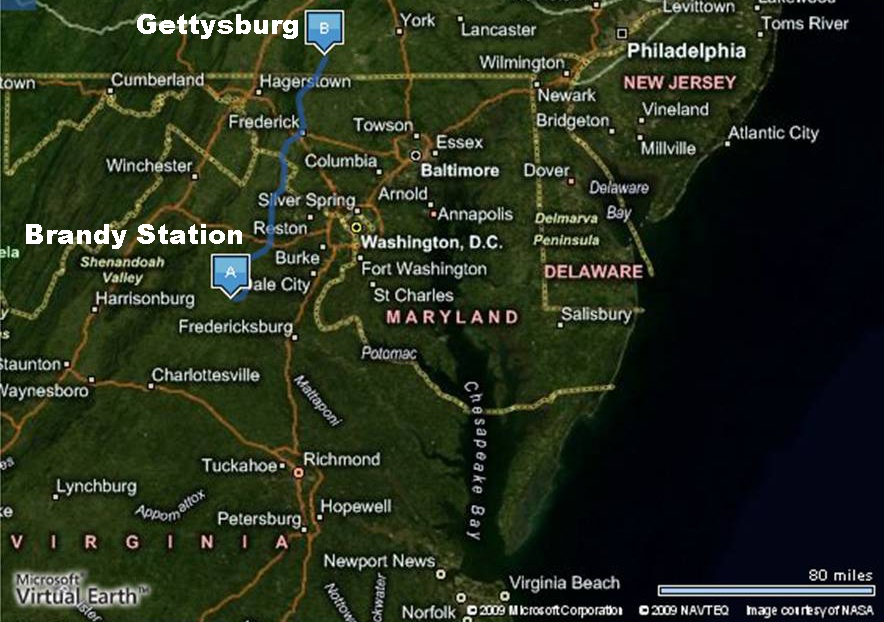
|
| Brandy Station : The Opening Battle of Gettysburg Campaign |
The Confederates had planned for June 9, 1863, to be a day of maneuver rather
than of battle. Two of the army's three infantry corps were near Culpeper, six miles southwest of Brandy Station, poised to
move into the Shenandoah Valley and thence up to Pennsylvania. Major General J.E.B. Stuart,
at Brandy Station, was to screen this movement with his 9,500-man cavalry division, while the remaining infantry corps held
the attention of the Union Army at Fredericksburg, 35 miles southeast of Brandy Station.
The Battle of Brandy Station was the largest cavalry battle ever fought on the North American continent. Of the 20,000 soldiers involved,
about 17,000 were cavalry. Brandy Station was also the first battle of the Gettysburg Campaign.
The Federals knew that Confederate cavalry was around Culpeper, but its intelligence
had not gathered information of the sizeable infantry force behind the horsemen. Army of the Potomac commander, Major General
Joseph Hooker, interpreted the enemy's cavalry presence around Culpeper to be indicative of preparations for a raid of his
army's supply lines. Accordingly, he ordered his Cavalry Corps commander, Brigadier General Alfred Pleasonton, to "break up Stuart's raid in its incipiency."
The Confederates apparently did not expect any harassment from the enemy
cavalry. The day before the important screening mission, the Southern troops conducted a grand review for General Robert E. Lee at Inlet Station, just two miles southwest of Brandy Station. Concurrently, 8,000 Federal cavalry organized into
three divisions, while an additional 3,000 Northern infantry prepared to disrupt the Confederate plans.

| Map of the Battle of Brandy Station: June 9, 1863 |
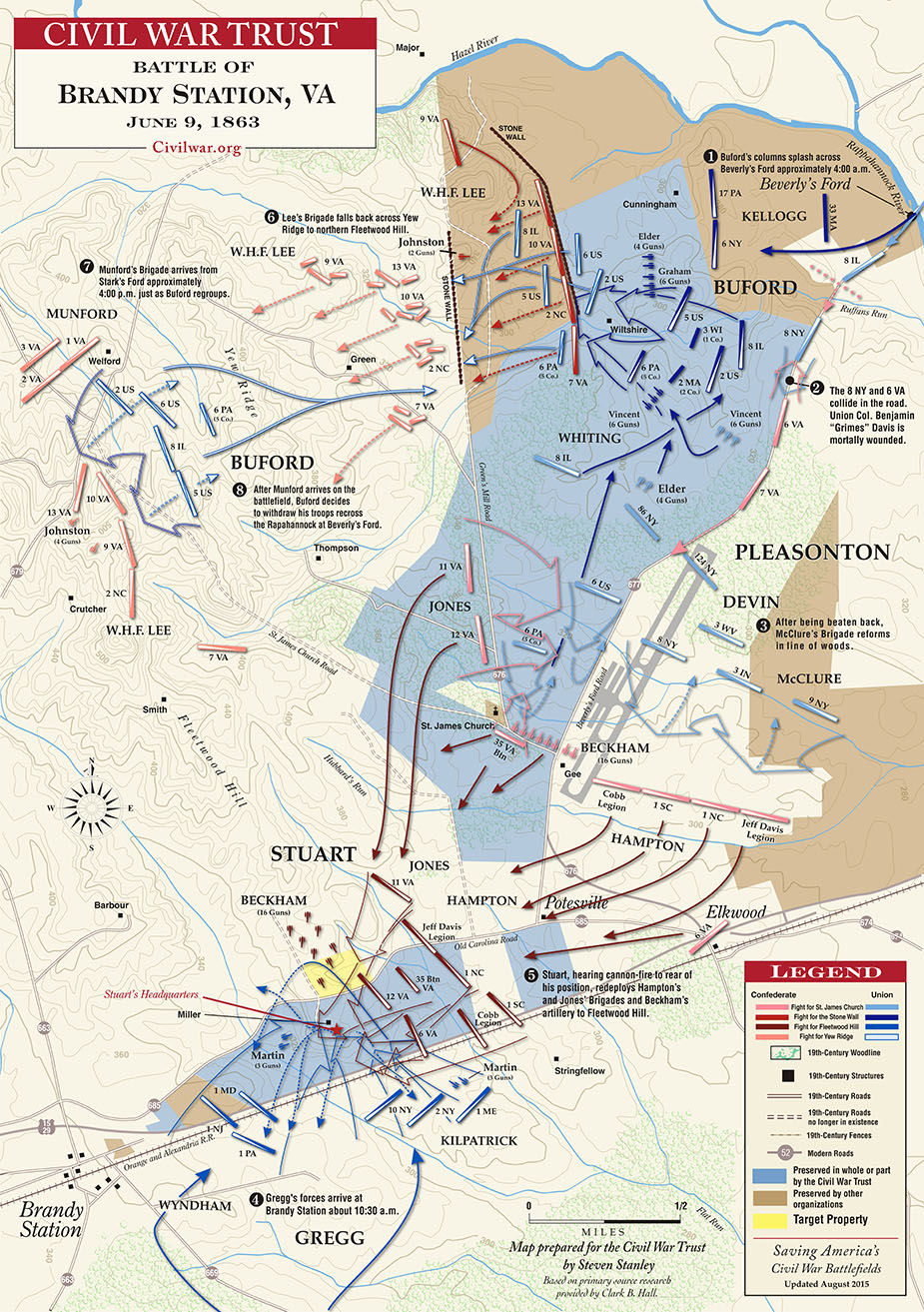
|
| Battle of Brandy Station |
(About) Battle of Brandy Station on June 9, 1863. This Civil War Trust map
shows the battle summary, troop movements, and battlefield area preserved, for the Battle of Brandy Station, Virginia.
| Battle of Brandy Station |
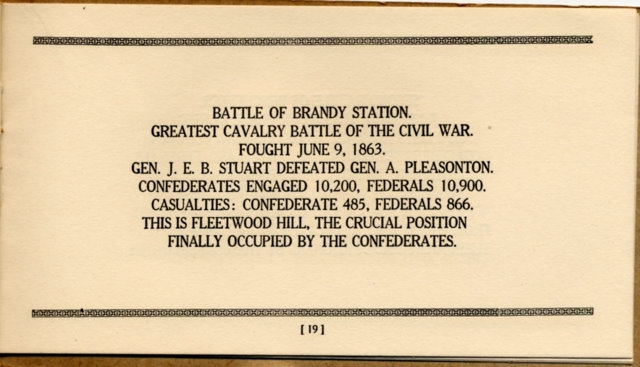
|
| (Historical Marker) |
Approximately 4:30 a.m. on June 9th, Brigadier General John Buford's column
of 5,500 soldiers splashed across the fog-shrouded Rappahannock River surprising the Confederate pickets at Beverly's Ford.
Nearby Southern horsemen from Brigadier General William "Grumble" Jones' brigade, awakened by the sound of gunfire, "rode
into the fray partially dressed and often riding bareback." They struck Buford's leading brigade, commanded by Colonel Benjamin
F. "Grimes" Davis, near a bend in the Beverly's Ford Road and temporarily checked its progress. Davis was also killed
in the fight. ("Grumble" Jones would be killed at the Battle of Piedmont on June 5, 1864.)
Davis' brigade had been halted just shy of where the Confederate artillery
was camped. Cannoneers swung one or two guns into position and fired down the road at Buford's men, enabling the other pieces
to escape and establish the foundation for the subsequent Confederate line. The artillery unlimbered at the Gee House and
at St. James Church -- structures located on two knolls on either side of the Beverly's Ford Road.
Most of Jones' command rallied to the left of this Confederate artillery line,
while Brigadier General Wade Hampton's brigade formed to the right. The 6th Pennsylvania Cavalry
suffered the greatest casualties of any regiment participating in the battle, when it unsuccessfully charged across a field
and into the very muzzles of the guns located at St. James Church.
Realizing that the Southern artillery blocking the direct route to Brandy Station was a force to be dislodged,
Buford determined to anchor his right on the Hazel River and try to turn the
Confederate left. But he found Brigade General W.H.F. "Rooney" Lee's brigade blocking his advance with some troops on a piece
of high ground called Yew Ridge; there were dismounted troopers positioned along a stone wall in front ("Rooney" being General
Robert E. Lee's son). The Federals sustained heavy losses; however, they repulsed the Confederates and secured the stone wall.
Buford's troops, expected a counterassault, but were
amazed at the Confederates' withdrawal.
| Gettysburg Campaign Map |
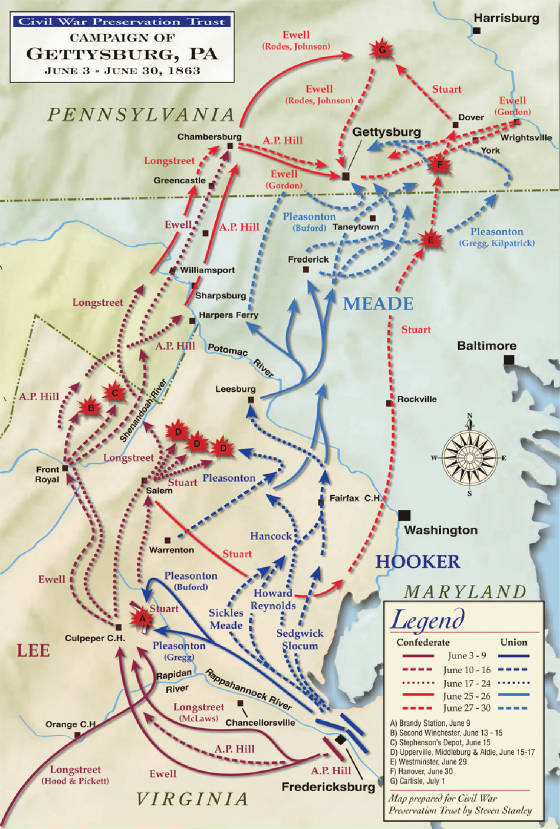
|
| Gettysburg Campaign |
| Brandy Station, June 9, 1863 |
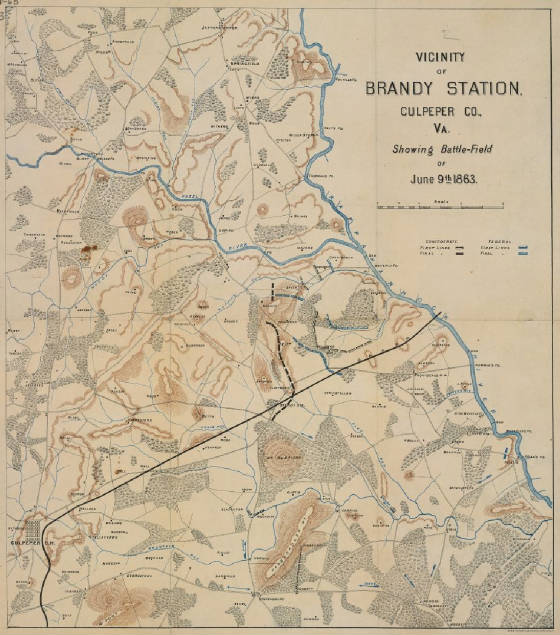
|
| Battle of Brandy Station |
(About) Historic map of Brandy Station and vicinity, ca. 1863.
The Southerners were shifting to meet a new threat, adjusting to their
second surprise of the day. Brigadier General David M. Gregg's Union division of about 2,800 men had orders to cross the Rappahannock
at Kelly's Ford and proceed on roads leading directly into Brandy Station, but discovered his way blocked by Brigadier General
Beverly Robertson's brigade. Gregg, however, realized that there were unguarded roads leading to the battlefield
by a more circuitous route. Following these roads, his lead brigade under Colonel Percy Wyndham arrived in Brandy Station
at about 11 a.m. Between Buford and Stuart was a prominent ridge called Fleetwood Hill. The eminence had been Stuart's
headquarters, but the general was at the front. When Gregg arrived, the only force on Fleetwood was a 6-pounder howitzer,
which had been sent to the rear for want of reliable ammunition. Major Henry B. McClellan of Stuart's staff pressed this gun
into service and sent a desperate plea to his chief for reinforcements. Wyndham, meanwhile, formed his men into line and charged
up the western slope of Fleetwood. As he neared the crest, the lead elements of Jones' brigade, which had just withdrawn from
St. James Church, rode over the crown.
Gregg's next brigade, led by Colonel Judson Kilpatrick, swung around east
of Brandy Station and attacked up the southern end and the eastern slope of Fleetwood Hill, only to discover that their appearance
coincided with the arrival of Hampton's Confederates. A series of confusing charges and countercharges swept back and forth
across the hill. The Confederates finally cleared the hill and captured three guns and inflicted 30 casualties among
the 36 men of the 6th New York Light Artillery, which had attempted to give close-range support to the Federal cavalry.
Colonel Alfred Duffie, with a small division, was delayed by two Confederate
regiments in the vicinity of Stevensburg and arrived on the field too late to participate in the action. While Jones and Hampton withdrew from their initial positions to fight at Fleetwood Hill,
"Rooney" Lee continued to assault Buford. Reinforced by Colonel Thomas Munford, commanding the brigade of the ailing
Fitzhugh Lee (General Robert Lee's nephew), "Rooney" Lee launched a counterattack against Buford. Concurrently, Pleasonton
had called for a general withdrawal. The battle was over.
Despite being surprised by his adversary twice in the same day, Stuart was
able to retain the field. Union losses numbered approximately 900,
while Confederate casualties were approximately 500. But the overwhelming superiority that the Confederate cavalry once enjoyed
was gone.
(Sources listed at bottom
of page.)
Recommended
Reading: Brandy Station, Virginia, June 9, 1863: The Largest
Cavalry Battle of the Civil War (Hardcover).
Description: The winter of 1862-1863 found Robert Lee’s Army of Northern Virginia and Ambrose Burnside’s Army
of the Potomac at a standoff along the Rappahannock River
in Virginia. In December 1862, outnumbered Confederate forces
had dealt the Union army a handy defeat in the Battle of Fredericksburg. A demoralized Union army was waiting for spring and
revitalization. The latter came in late January 1863 in the form of Major General Joseph "Fighting Joe" Hooker. Relieving
the disgraced and outmatched Burnside, Hooker reorganized his troops, establishing regular drills, procuring adequate rations
and instituting company colors, thereby giving his soldiers back their fighting spirit. Lee, also with his eye on the spring
campaign, concentrated on maintaining his strength and fortifications while struggling with the ever-increasing problem of
adequate supplies. Continued below…
As the spring
campaign--and Hooker’s new fighting approach--began, cavalry units from both sides took on an increased importance.
This culminated in the largest cavalry battle of the war, fought near Brandy Station, Virginia on June 9, 1863. Compiled from various contemporary
sources, this volume details the contributions of cavalry units during the spring campaign of 1863. Although the work discusses
early encounters such as the Battle of Chancellorsville, the main focus is the Battle of Brandy Station, which marked the
opening of the Gettysburg campaign and Lee’s last offensive
into the North. Here, forces commanded by J.E.B. Stuart and Alfred Pleasanton fought a battle which ranged over 70 square
miles but left no decisive victor. At the end of the day, Confederate troops were still in possession of the territory and
counted fewer casualties, yet Union forces had definitely taken the offensive. While historians still debate the significance
of the battle, many now view it as a harbinger of change, signifying the beginning of dominance of Union horse soldiers and
the corresponding decline of Stuart’s Confederate command. Appendices contain information on individual units with recorded
casualties and a list of West Pointers who took part in the battle. Photographs and an index are also included.
Advance to:
Recommended Reading: The Cavalry at Gettysburg: A Tactical Study of Mounted
Operations during the Civil War's Pivotal Campaign, 9 June-14 July 1863. Description: "For cavalry and/or Gettysburg
enthusiasts, this book is a must; for other Civil War buffs, it possesses the qualities sought by students of the conflict.
. . . [It] bristles with analysis, details, judgments, personality profiles, and evaluations and combat descriptions, even
down to the squadron and company levels. The mounted operations of the campaign from organizational, strategic, and tactical
viewpoints are examined thoroughly. The author's graphic recountings of the Virginia fights
at Brandy Station, Aldie, Middleburg, and Upperville, the Pennsylvania encounters at Hanover, Hunterstown, Gettysburg, and
Fairfield, and finally the retreat to Virginia, are the finest this reviewer has read under a single cover. Continued
below...
For those who
enjoy the thunder of hoofbeats, the clang of sabers, and the crack of pistols and carbines, this book has all of it. Generals
and privates share the pages, as the mounted opponents parry and thrust across hundreds of miles of territory from June 9
to July 14, 1863."-Civil War Times Illustrated (Civil War Times Illustrated).
Recommended
Reading: Plenty of Blame to Go Around: Jeb Stuart's Controversial Ride to Gettysburg (Hardcover). Description: In June 1863, the Gettysburg Campaign
is in its opening hours. Harness jingles and hoofs pound as Confederate cavalryman James Ewell Brown (JEB) Stuart leads his
three brigades of veteran troopers on a ride that triggers one of the Civil War's most bitter and enduring controversies.
Instead of finding glory and victory-two objectives with which he was intimately familiar-Stuart reaped stinging criticism
and substantial blame for one of the Confederacy's most stunning and unexpected battlefield defeats. In Plenty of Blame to
Go Around: Jeb Stuart's Controversial Ride to Gettysburg,
Eric J. Wittenberg and J. David Petruzzi objectively investigate the role Stuart's horsemen played in the disastrous campaign.
It is the first book ever written on this important and endlessly fascinating subject. Continued below…
Stuart left
Virginia
under acting on General Robert E. Lee's discretionary orders to advance into Maryland and
Pennsylvania, where he was to screen Lt. Gen. Richard Ewell's
marching infantry corps and report on enemy activity. The mission jumped off its tracks from virtually the moment it began
when one unexpected event after another unfolded across Stuart's path. For days, neither Lee nor Stuart had any idea where
the other was, and the enemy blocked the horseman's direct route back to the Confederate army, which was advancing nearly
blind north into Pennsylvania. By the time Stuart reached
Lee on the afternoon of July 2, the armies had unexpectedly collided at Gettysburg,
the second day's fighting was underway, and one of the campaign's greatest controversies was born. Did the plumed cavalier
disobey Lee's orders by stripping the army of its "eyes and ears?" Was Stuart to blame for the unexpected combat the broke
out at Gettysburg on July 1? Authors Wittenberg and Petruzzi, widely recognized for their study and expertise of Civil War cavalry
operations, have drawn upon a massive array of primary sources, many heretofore untapped, to fully explore Stuart's ride,
its consequences, and the intense debate among participants shortly after the battle, through early post-war commentators,
and among modern scholars. The result is a richly detailed study jammed with incisive tactical commentary, new perspectives
on the strategic role of the Southern cavalry, and fresh insights on every horse engagement, large and small, fought during
the campaign. About the author: Eric J. Wittenberg has written widely on Civil War cavalry operations. His books include Glory
Enough for All (2002), The Union Cavalry Comes of Age (2003), and The Battle of Monroe's Crossroads and the Civil War's Final
Campaign (2005). He lives in Columbus, Ohio.
Recommended
Reading: The Mutiny at
Brandy Station: The Last Battle of the Hooker Brigade (Hardcover). Description: THE MUTINY AT BRANDY STATION presents, in microcosm, the character and actions of men who
served the United States Army of the Potomac in 1864. The story follows key players through
the reorganization, the courts martial, and into the Wilderness using direct quotes from their diaries, memoirs, and reports
as well as original transcripts of the trials. 78 black and white illustrations.
Recommended Reading: The Union Cavalry Comes of Age: Hartwood
Church to Brandy Station, 1863.
Description: In The Union Cavalry Comes of Age, award-winning cavalry historian Eric J. Wittenberg provides a long-overdue
challenge to the persistent myths that have unfairly elevated the reputations of the Confederate cavalry’s “cavaliers”
and sets the record straight regarding the evolution of the Union cavalry corps. He highlights the careers of renowned Federal
officers, including George Stoneman, William W. Averell, Alfred Pleasonton, John Buford, and Wesley Merritt, as well as such
lesser-known characters as Col. Alfred Duffie, a French expatriate who hid an ugly secret. Continued below…
Wittenberg writes a lively, detailed account of a saber-slashing era in which
men fought for duty, honor, and bragging rights. Indeed, a taunting note left behind by Confederate Brig. Gen. Fitzhugh Lee
on a raid at Hartwood Church, Virginia,
in 1863 sparked Northern retaliation at the Battle of Kelly’s Ford. The Federal cavalry then evolved during the trials
of Stoneman’s Raid, with their hard work culminating in the Battle of Brandy Station, where they nearly broke the unsuspecting
Confederates in a fourteen-hour maelstrom that is considered the greatest cavalry battle ever fought in North
America. A skillfully woven overview, this unforgettable story also depicts the strategic and administrative tasks
that occupied officers and politicians as well as the day-to-day existence of the typical trooper in the field. The Union
Cavalry Comes of Age shows that Northern troopers began turning the tide of the war much earlier than is generally acknowledged
and became the largest, best-mounted, and best-equipped force of horse soldiers the world had ever seen.
Sources: National Park Service;
Fredericksburg and Spotsylvania National Military Park; Official Records of the Union and Confederate Armies; Civil War Preservation
Trust; National Archives; Library of Congress; Microsoft Virtual Earth; Clark, Champ, and the Editors of Time-Life Books,
Gettysburg: The Confederate High Tide, Time-Life Books, 1985, ISBN 0-8094-4758-4; Coddington, Edwin B., The Gettysburg Campaign;
a study in command, Scribner's, 1968, ISBN 0-684-84569-5; Custer, Andie, "The Knight of Romance", Blue & Gray magazine
(Spring 2005); Eicher, David J., The Longest Night: A Military History of the Civil War, Simon & Schuster, 2001, ISBN
0-684-84944-5; Kennedy, Frances H., Ed., The Civil War Battlefield Guide, 2nd ed., Houghton Mifflin Co., 1998, ISBN 0-395-74012-6;
Longacre, Edward G., The Cavalry at Gettysburg, University of Nebraska Press, 1986, ISBN 0-8032-7941-8; Loosbrock, Richard
D., "Battle of Brandy Station", Encyclopedia of the American Civil War: A Political, Social, and Military History, Heidler,
David S., and Heidler, Jeanne T., eds., W. W. Norton & Company, 2000, ISBN 0-393-04758-X; Sears, Stephen W., Gettysburg,
Houghton Mifflin, 2003, ISBN 0-395-86761-4; Salmon, John S., The Official Virginia Civil War Battlefield Guide, Stackpole
Books, 2001, ISBN 0-8117-2868-4; Wittenberg, Eric J., and J. David Petruzzi, Plenty of Blame to Go Around: Jeb Stuart's Controversial
Ride to Gettysburg,
Savas Beatie, 2006, ISBN 1-932714-20-0.
|

